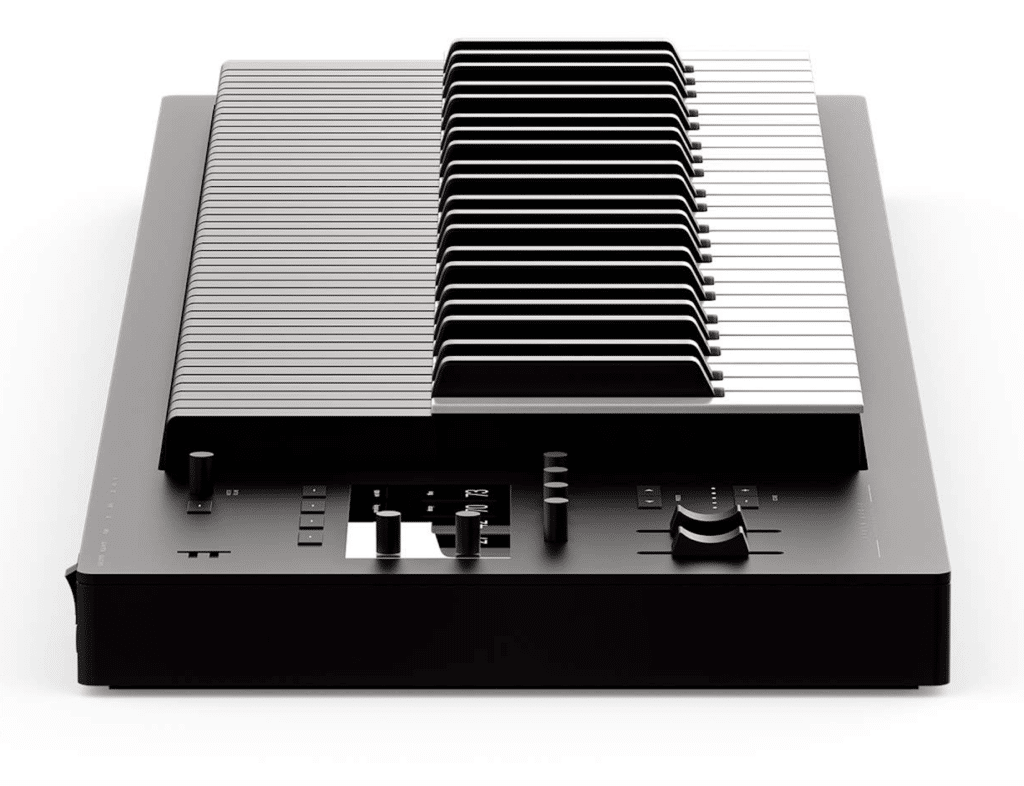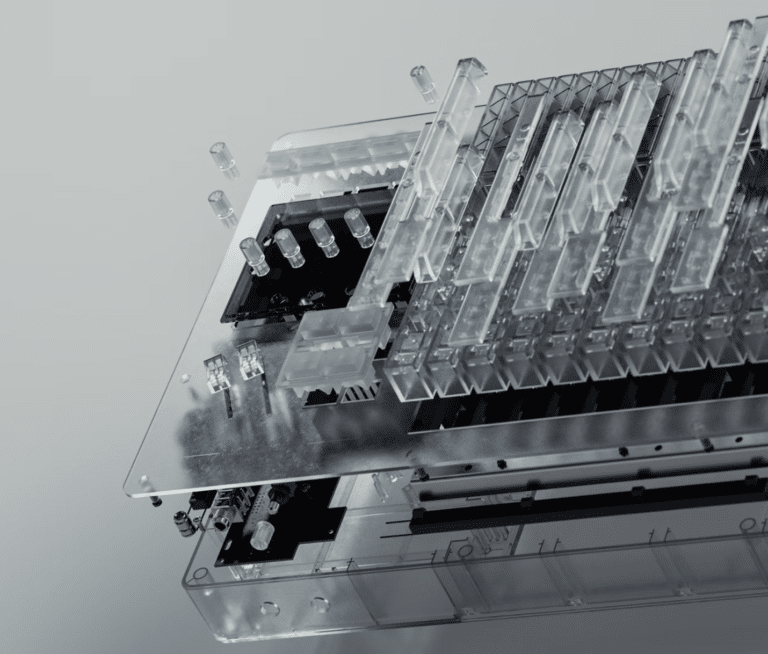Last Updated on February 4, 2024 by IDS Team
The Osmose keyboard is the first hardware synth from this small French company, but this Expressive E Osmose review will dig into whether it really lives up to the hype.
Interested in new, inventive, higher end hardware synths? Expressive E has focused on mpe synths and polyphonic aftertouch for a while since its inception in 2015. For this all new polyphonic synthesizer keyboard, Espressive E teamed up with Haken Audio to create the digital modular engine, too.
The Osmose follows Expressive E’s first release, the Touche midi polyphonic expression aftertouch keyboard. Now we have the Osmose mpe synth, which is also polyphonic aftertouch, but is it a worthy successor? We decided to take a deep dive into the features of this polyphonic synthesizer keyboard and whether it lives up to the hype that has heralded it since its announcement. We’ll also break down similarities and differences in our osmose vs seabord series comparison with the two ROLI Seabord models.
What is the Expressive E Osmose?
As stated, the osmose synth is quite simply, the first hardware instrument from Expressive E, a company whose aim is to improve the interactive elements of music creation. It does this by focussing on musician and hardware synth interactions, ensuring that these replicate true-to-life experiences of playing an instrument as much as possible.
This means working with features like aftertouch, midi polyphonic expression (MPE), and so on to make smooth sounds and a user experience that feels just like you’re playing a real instrument. The Expressive E Osmose 49 Key Keyboard is designed specifically to mimic features like guitar string bending and vibrato. This may sound weird, but we’ll break it down in a later section. First, let’s look at how the Osmose Polyphonic Aftertouch Synthesiser actually sounds.

What’s the sound quality like?
Of course, sound is relatively subjective and it depends on what kind of synth you want. The Osmose is smooth and slick, it’s definitely a modern synth and it’s not deliberately designed to emulate any retro machines.
The mpe and aftertouch are features that appeal to many musicians regardless of your genre or preferred style of synth, however. Does the Osmose show enough versatility to be worth it if you want something a bit different sounding?
The answer is a resounding yes. First up, there are some very impressive preset sounds including brass and woodwind. Whilst these do sound obviously synthesized at the beginning, moderating them with the Osmose’s intuitive controls adds little bits of flair such as woodwind vibrato that turn them from classic synth tones to extremely realistic, almost true to life sounding.
Synth strings and the pitch bending feature are also no less impressive. The high-quality manufacturing and subtlety of the sound produced make this a very original synth that is dripping with emotional expression.
What’s the full range of features of the Osmose?
The Osmose polyphonic synthesizer keyboard is designed to be fun and intuitive to play, but what features does it actually have? Below are just some of the things that give it its well-deserved ‘expressive’ title.
- Reverb and delay processing
- EQ and compression
- Ability to pitch bend, add vibrato, slide, and more
- Pitch bending and modulation sliders are easily accessible, right next to 49 full-size weighted keys
- Over 500 presets
- Sensitivity controls
- Ability to switch to a classic (non mpe) keyboard
- Usability as a midi controller
- Built-in arpeggiator with glide control
Apart from these, the Osmose’s digital modular engine from Haken Audio is modern, inventive, and comes up with flexible, high-quality sounds. Haken Audio are the makers of the Continuum Fingerboard, which is designed for similarly intuitive playing – so they really get what Expressive E were trying to achieve with the Osmose.
Is there any reason you might not get the Expressive E Osmose?
The Osmose has been hyped a lot, but does it do what it says on the tin? Ultimately, the answer is yes, it absolutely does. If you have the budget for it, significantly rely on synthesis as a major part of your music, and don’t have any super niche or specific needs, the answer is a resounding yes.
It’s really high quality, and another good thing is the different sounds are all very divergent from each other, this is not a one trick pony at all, nor is it just relying on its expressive key manipulation as a selling point.
Expressive E Osmose Review: Note Expression Features
The note expression features include bend, tap, pressure, glide, and wiggle amongst others.
Generally these features are really, really sensitive. Not only is this one of the first synths doing something exactly like this, it does it to a really high quality. It is sometimes billed as a polyphonic aftertouch synthesizer, but it has so much more than just aftertouch!
Make no mistake, the osmose synth keyboard is also easy to control at the same time. You could say the benefits of having the effects on a synth as opposed to a violin or guitar is that they are ultra smooth. Some might argue this takes away the character associated with a real musician playing vibrato, but come on.
The uncanny combination of these subtle additions to a motif with the smoothness of the synth is familiar yet refreshing at the same time. It’s pretty groundbreaking, and it’s hard to believe nobody has done this before Expressive E.
Ultimately some of these features you may not think would make much of a difference. But once you hear the Osmose in action, there is a certain je ne sais quoi about it, the same way a vinyl record with imperfections, undertones, and overtones sounds better, the Osmose just feels more organic and full of character.
How many notes of polyphony does the Osmose have?
For the osmose, expressive e uses 49 notes of polyphony with weighted keys for a super smooth and hyper-realistic playing experience.
How exactly do the features that it advertises work? One of the most significant is the ‘key wobble’. This is exactly what it sounds like, as you press a key down you can actually wobble it from side to side to create a vibrato sound.
All synths to a greater or lesser extent can claim to be ‘expressive. However, the expressive E truly does deserve the moniker within its name for this feature.
What are the dimensions of the Osmose?
The Osmose is a relatively chunky synth with dimensions of 894 x 316 x 87.5 mm / 35.2″ x 12.4″ x 3.4″. It’s not a small mpe controller and weighs 8.4kg or 18.4 pounds. Of course, the sie is also why it’s on the higher end price-wise – though not to mention the quality.
Expressive S Osmose vs ROLI Seabord
The ROLI Seaboard series (RISE 2 and Block M) is one of the closest competitors to the osmose, but how do the two stack up next to each other? Ultimately it’s down to personal preference but it’s important to know some key differences so you can see how they fit in with your playing style.
No Expressive E Osmose review could go without looking at its nearest competitors, so here goes. For convenience, this table will look at the Osmose vs Seabord series from ROLI in general, although there are different models within this.
Osmose VS Seabord Comparison
| Seaboard Series | Osmose |
| No such feature | Expressive keys allow you to perform playable, then and there vibrato like a guitar or violin. An amazing intuitive feature for those who want it |
| Greater intuitiveness in terms of navigating through the operating system, ability to slide fingers across keys and open up filters and other features | Navigation happens regularly via a menu |
| Comes with a plugin synth that operates as a vst on your computer | No VST, but built and designed in tandem with Haken (makers of the Continuum Fingerboard) with a powerful inbuilt synthesizer |
| Depending on model, more pitch-sweeping possibilities | On the more expensive side and not necessarily affordable for bedroom producers, can reach over 1500 USD |
| Goes into greater depth with nuanced playing such as microtones and guitar or violin-style string bending and vibrato | No vst, but built and designed in tandem with Haken (makers of the Continuum Fingerboard) with a powerful inbuilt synthesizer |
| More easily navigable hardware depending on your preference, easy to learn to play | Very intuitive screen and preset menus, but no option to immediately access filters and other features |
Do you want a look at another great MPE offering from ROLI? We have a comparison of the Equator Two right here!
Final Thoughts
To wrap up our expressive e osmose review, we will say this: It’s difficult to ever choose the ‘best’ synth in any category. However, the Osmose is a much-anticipated synth and as the first hardware synth from Expressive E it does live up to the promises that have gained this company’s fans. The osmose is smooth, expressive, and true to life, it delivers on the features it promises but the only downside is it is quite expensive and there was a wait list as of last year.
The Osmose may not be viable for everyone, but for those whose interests lie within its fields of specialism, it is an exciting and hotly anticipated synth that absolutely deserves the expressive reputation it has.
Looking for more low downs on what’s currently out there?
If you like MPE synths, we look at some of the best mpe synths here. And, if you want more hardware reviews, we have an entire hardware section here.



